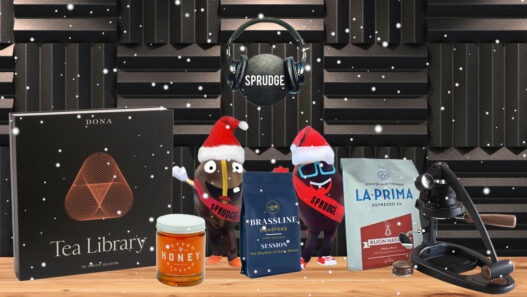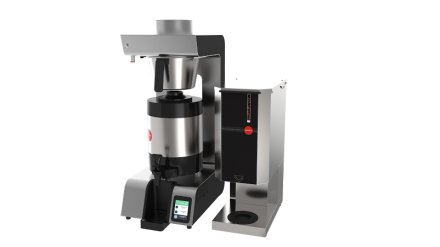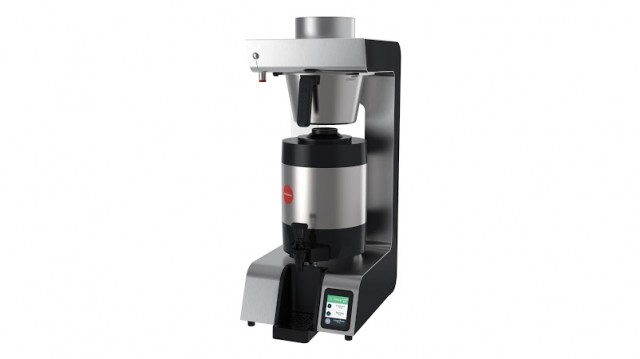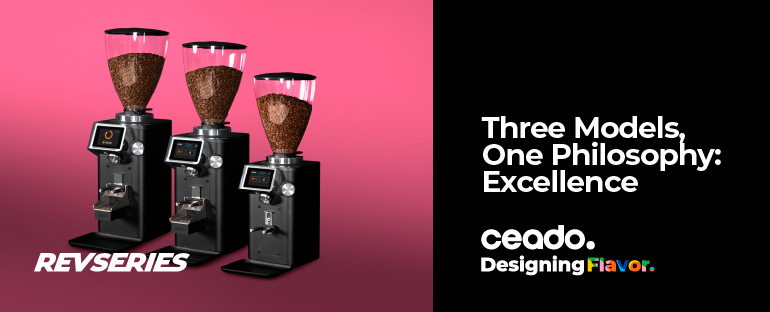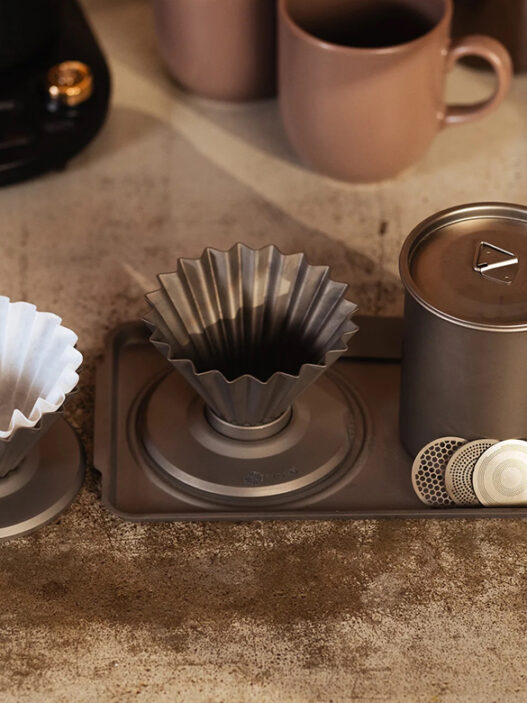Tech nerds and coffee gear heads, rejoice! As we shift into what should be a wild weekend of product launches at Host – the coffee industry’s equivalent of the E3 event, held ever other year in Italy – Sprudge.com will be bringing you a whole holy host of first looks and brewing wonders making their debut in Milan.
Up first, meet JET, a brand new batch brewer from Ireland’s Marco Beverage Systems. JET is a filter coffee brewer with a vacuum insulated dispenser, and it comes with an optional paired grinder meant to “slave” right next to the brew device. It can brew between 2.0 to 6.0 litres of coffee at a time, and features a handy touch-screen interface. JET was designed to SCAE Gold Cup brewing standards, which is kind of an industry codified way of saying, “it brews coffee well” – it’s an internationally respected set of rules on brewing filter coffee. JET is also, and let’s be real here, pretty sleek and cool looking, which has become something of a Marco product standard over the years.
JET’s public debut is when the show opens on Friday morning, EuroZone Time, leading up to a public launch in early 2014, so all we’ve got today image-wise are these advance renderings from Marco. But we did manage to score a short sit down with David Walsh, R&D Manager at Marco and a well-known brain in the specialty coffee world. Here’s some bits from our chat with him.
David, please talk to us about JET’s precision specs – what degree of precision are we talking here? Can you tell us more about the rate of variance this machine displays for temperature?
David Walsh: It’s probably worth sharing where this machine is in its development life-cycle for context. The machine we are showing at HOST is a second iteration functional prototype. So we are edging closer to locking in the final design, but things will change prior to hitting the market early 2014. So far though, the performance has been incredibly promising, reaffirming the core design choice (the Pillar heritage). In terms of numbers we are currently looking at less than 1% variance in water volume delivery, and about +/- 1.5C temperature delivery (from the sprayhead) even at this early stage. We have kicked about the idea of having an “Uber mode” for temperature, which would bring the temperature variance down to a fraction of a degree, but have a negative impact on the maximum brew volume. We’re not sure anyone really wants that much precision, but I like the idea. Even as a user selectable option, it fits with our own ethos as well.
Can you tell us a bit more about the touch display? Is there deep functionality with the touch display, or is it mostly pre-set?
The touch screen display functionality is deep already and will be getting deeper. From the display you can set the primary mode of operation (grinder, pack or manual). Then you are guided through a quick calibration procedure for the brewer and the grinder, and you enter numbers back into the system. After that you setup your desired coffee to water ratio (eg 60g/L), and define your preset brews in terms of the volume of beverage you want, and the brew time (water dispense time), and the machine does the math. So when you want to brew a batch, you select the volume of coffee you want, the machine guides you through the steps, initiates the grinder to give you the required dose, and then initiates the brewing cycle. That’s the core functionality, on top of that you have stuff like real-time clock so you can automatically turn the machine on and off when not in use, and SD card slot for updating software / graphics, and some other surprises for further down the line. I have some easter-eggs I want to put in there.
Can you tell us more about JET’s energy efficiency standards? The one sheet we got in advance of JET’s launch claims that it will have “best in class energy efficiency” – what are you referring to there?
We are referring to the class of batch brewers that dispense via gravity to a sprayhead over a basket. This includes our own Filtro Shuttle and Mini Filtro Shuttle brewers, and a number of our peers mostly from the US. The characteristics of these machines have generally been, massive big water tank (20L +), often using this as a means of thermal stability (even though we are only brewing 6L). This design can achieve good consistency of temperature, but at the expense of energy efficiency and to a degree brew volume consistency. We’ve taken a different approach, our hot water tank holds less water than our maximum brew volume, in certain variants the tank will almost completely drain by the end of the brew, we are storing as little water as possible. People sometimes think of good engineering as being belts and braces, excess, over-engineering. I like to think of good engineering as “just enough”. Waste is waste, whether it be heat/energy, material, time. Let’s not use efficiency to compensate for the weaknesses in our design.
Last, who do you think is the ideal JET end user?
Someone who pays for the machine on time, and likes it a lot.








